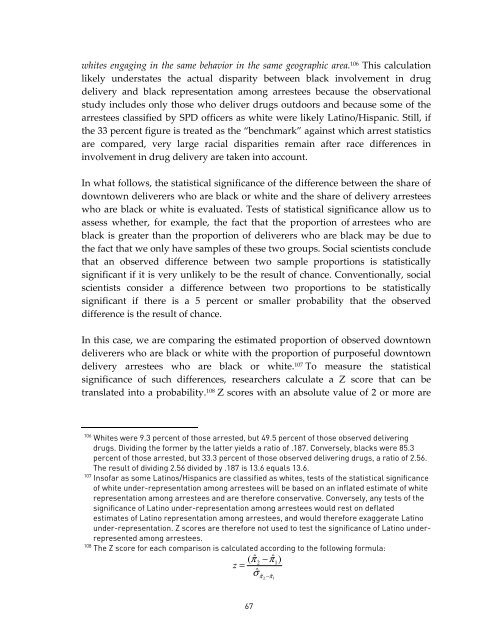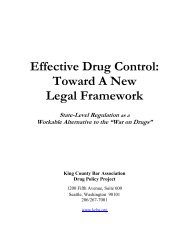RACE AND THE ENFORCEMENT OF DRUG DELIVERY LAWS IN ...
RACE AND THE ENFORCEMENT OF DRUG DELIVERY LAWS IN ...
RACE AND THE ENFORCEMENT OF DRUG DELIVERY LAWS IN ...
You also want an ePaper? Increase the reach of your titles
YUMPU automatically turns print PDFs into web optimized ePapers that Google loves.
whites engaging in the same behavior in the same geographic area. 106 This calculation<br />
likely understates the actual disparity between black involvement in drug<br />
delivery and black representation among arrestees because the observational<br />
study includes only those who deliver drugs outdoors and because some of the<br />
arrestees classified by SPD officers as white were likely Latino/Hispanic. Still, if<br />
the 33 percent figure is treated as the “benchmark” against which arrest statistics<br />
are compared, very large racial disparities remain after race differences in<br />
involvement in drug delivery are taken into account.<br />
In what follows, the statistical significance of the difference between the share of<br />
downtown deliverers who are black or white and the share of delivery arrestees<br />
who are black or white is evaluated. Tests of statistical significance allow us to<br />
assess whether, for example, the fact that the proportion of arrestees who are<br />
black is greater than the proportion of deliverers who are black may be due to<br />
the fact that we only have samples of these two groups. Social scientists conclude<br />
that an observed difference between two sample proportions is statistically<br />
significant if it is very unlikely to be the result of chance. Conventionally, social<br />
scientists consider a difference between two proportions to be statistically<br />
significant if there is a 5 percent or smaller probability that the observed<br />
difference is the result of chance.<br />
In this case, we are comparing the estimated proportion of observed downtown<br />
deliverers who are black or white with the proportion of purposeful downtown<br />
delivery arrestees who are black or white. 107 To measure the statistical<br />
significance of such differences, researchers calculate a Z score that can be<br />
translated into a probability. 108 Z scores with an absolute value of 2 or more are<br />
106 Whites were 9.3 percent of those arrested, but 49.5 percent of those observed delivering<br />
drugs. Dividing the former by the latter yields a ratio of .187. Conversely, blacks were 85.3<br />
percent of those arrested, but 33.3 percent of those observed delivering drugs, a ratio of 2.56.<br />
The result of dividing 2.56 divided by .187 is 13.6 equals 13.6.<br />
107 Insofar as some Latinos/Hispanics are classified as whites, tests of the statistical significance<br />
of white under-representation among arrestees will be based on an inflated estimate of white<br />
representation among arrestees and are therefore conservative. Conversely, any tests of the<br />
significance of Latino under-representation among arrestees would rest on deflated<br />
estimates of Latino representation among arrestees, and would therefore exaggerate Latino<br />
under-representation. Z scores are therefore not used to test the significance of Latino underrepresented<br />
among arrestees.<br />
108<br />
The Z score for each comparison is calculated according to the following formula:<br />
( ˆ π ˆ<br />
2<br />
−π1)<br />
z =<br />
ˆ<br />
σ π<br />
π<br />
ˆ2 − ˆ1<br />
67

















